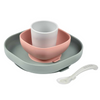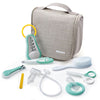Kelly Benton – Pregnancy & Baby Nutritionist
As parents, we all want to provide our children with the best start in life, and a crucial aspect of that journey is crafting well-balanced meals that cater to their growing needs. In this blog post, we're diving into the art of building the perfect plate for your little one. Before we do this, it’s important to remember your role during mealtimes, which is to decide when and where mealtimes occur, and what foods your little one is offered. It is also your role to let baby lead when deciding which of those foods they eat, how much they eat, and whether they eat anything at all. Taking this approach to mealtime can foster a positive relationship with food for your child, which can reduce the likelihood of picky eating in toddlerhood1 and influence their attitudes and behaviour towards food as an adult.

In the beginning, meals should be less about portion sizes and more about nutrient density, as baby's don't eat much, so we want what they do eat to be jam-packed with nutrients, especially iron and zinc as requirements for these nutrients increase from 6 months of age.
Follow this simple guide to build healthy, balanced meals for your little one every time!
- Iron-rich proteins: think beef, lamb, grass-fed liver, sardines, chicken and legumes. Iron is a key nutrient for babies 6-12 months of age, needing more iron per day than an adult male. When following a baby-led weaning approach, ensure you offer this food up first to ensure baby doesn't fill up on fruit / veg before you get to it. Aim for at least 1 iron-rich food with every meal.
- Veggies + fruit: For carbohydrates and essential micronutrients. Ensure you offer the colours of the rainbow across the week to broaden bubs exposure to different nutrients and where possible buy in season, which is often cheaper and at peak freshness. Use these rough ratios to balance out their fruit and veg intake:
- ¼ plate starchy veg or whole food carbohydrates: sweet potato, carrot, pumpkin, beetroot, parsnip, and grains such as quinoa, oats, buckwheat.
- ¼ plate non-starchy veg: broccoli, zucchini, tomato, eggplant, capsicum, cucumber.
- ¼ plate fruit: berries, kiwi fruit, apple, pear, peaches, plums.
- Healthy fat: The macronutrient often missing from store-bought baby food! Yet fat is necessary to protect major organs, support absorption of vitamins A, D, E & K, provides fullness and stabilises blood sugar. Foods such as avocado, coconut, extra virgin olive oil and nut butters are incredibly nourishing and can also make many foods, such as vegetables, more palatable. Aim for around 1-2 tsp with each meal.
- Flavour & seasoning: The best way to encourage adventurous eaters? Add flavour! Think lemon, garlic, fresh herbs, and spices. All these foods add their own nutritional benefits too, so don’t be afraid to add flavour to your child’s food. Research suggests exposing your baby to a wide variety of flavours can increase their willingness to try new foods2.
If you are struggling to get your baby to eat a certain food, remember it can take up to 10-15 exposures to a food before it becomes part of their regular diet3, so don’t be put off after an initial rejection. Remember the division of responsibility and continue to offer the food regularly without pressure. Goodluck!

Kelly Benton is a Nutritionist specialising in maternal and baby nutrition. She is a mother of two little ones, right there in the thick of it with you. After experiencing maternal nutrient depletion through her first pregnancy and postpartum period, Kelly saw a need to educate and empower other women to proactively take health into their hands so they can have a more positive experience. Kelly is available for 1:1 consults, to book please visit her website or Instagram page.
References:
- Cole, N.C., An, R., Lee, S., Donovan, S.M. (2017). Correlates of picky eating and food neophobia in young children: a systematic review and meta-analysis, Nutrition Reviews, Volume 75, Issue 7. DOI: https://doi.org/10.1093/nutrit/nux024
- Harris, G., Coulthard, H. (2016). Early Eating Behaviours and Food Acceptance Revisited: Breastfeeding and Introduction of Complementary Foods as Predictive of Food Acceptance. Current Obesity Report. 5(1). DOI: https://doi.org/10.1007%2Fs13679-016-0202-2
- Scaglioni, S., De Cosmi, V., Ciappolino, V., Parazzini, F., Brambilla, P., Agostoni, C. (2018). Factors Influencing Children's Eating Behaviours. Nutrients. 10(6). DOI: https://doi.org/10.3390%2Fnu10060706












































